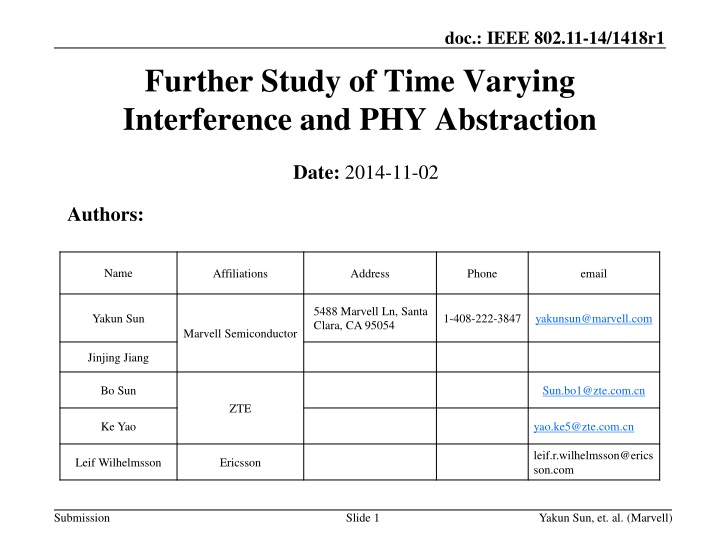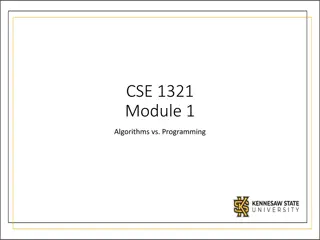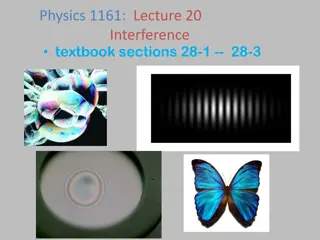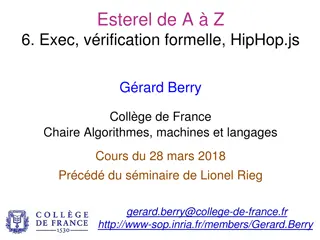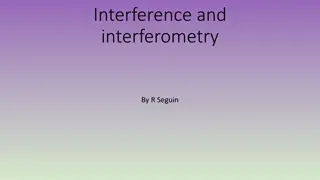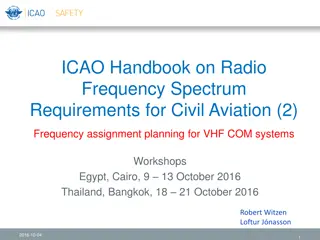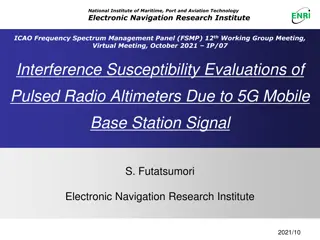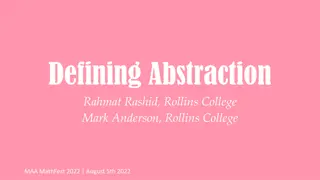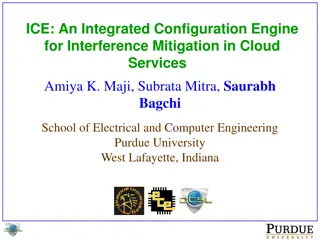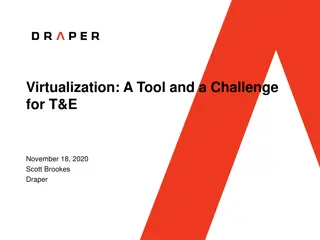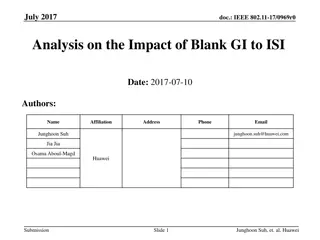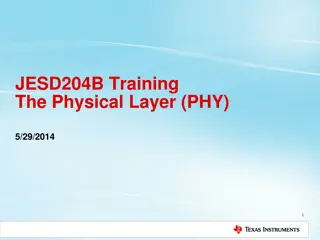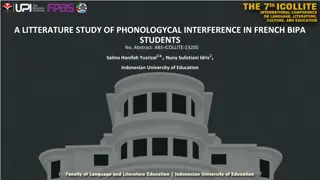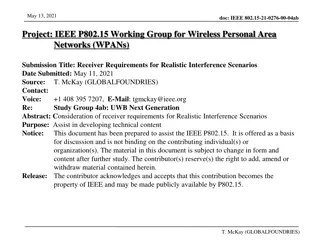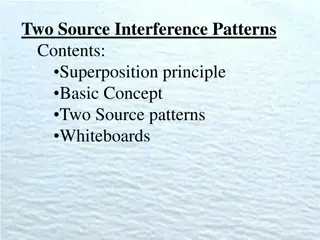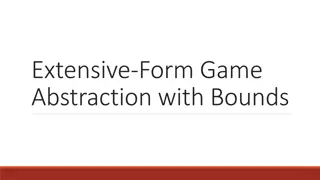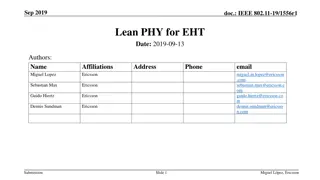Further Study of Time Varying Interference and PHY Abstraction
This study delves into the modeling of time-varying interference in the context of IEEE 802.11-14/1418r1. The research explores different interference models, highlighting the accuracy of block-wise PER modeling. Concerns regarding the necessity of incorporating time-varying interference and simulation assumptions are examined, supported by statistical interference data obtained through system level simulations. Detailed interference statistics and analysis are presented, shedding light on the dynamics and impact of time-varying interference in wireless communication scenarios.
Download Presentation

Please find below an Image/Link to download the presentation.
The content on the website is provided AS IS for your information and personal use only. It may not be sold, licensed, or shared on other websites without obtaining consent from the author.If you encounter any issues during the download, it is possible that the publisher has removed the file from their server.
You are allowed to download the files provided on this website for personal or commercial use, subject to the condition that they are used lawfully. All files are the property of their respective owners.
The content on the website is provided AS IS for your information and personal use only. It may not be sold, licensed, or shared on other websites without obtaining consent from the author.
E N D
Presentation Transcript
doc.: IEEE 802.11-14/1418r1 Further Study of Time Varying Interference and PHY Abstraction Date: 2014-11-02 Authors: Name Affiliations Address Phone email 5488 Marvell Ln, Santa Clara, CA 95054 Yakun Sun 1-408-222-3847 yakunsun@marvell.com Marvell Semiconductor Jinjing Jiang Bo Sun Sun.bo1@zte.com.cn ZTE Ke Yao yao.ke5@zte.com.cn leif.r.wilhelmsson@erics son.com Leif Wilhelmsson Ericsson Submission Slide 1 Yakun Sun, et. al. (Marvell)
doc.: IEEE 802.11-14/1418r1 Introduction Basic procedure of PHY abstraction in [1] is open to how to model time-varying interference. Different models have been studied in [2], among which a block-wise PER model has been shown to be more accurate. Some further studies on the time-varying interference are presented here. Submission Slide 2 Yakun Sun, et. al. (Marvell)
doc.: IEEE 802.11-14/1418r1 Concerns on Time Varying Interference Modeling There have been concerns regarding the necessity of modeling time-varying interference. How often a MPDU sees time-varying interference? How large the interference level changes? We collected the statistics of interference through integrated system level simulation. Submission Slide 3 Yakun Sun, et. al. (Marvell)
doc.: IEEE 802.11-14/1418r1 Simulation Assumptions Residential (Scenario 1) 4 STAs per apartment 2.4GHz, each AP in an apartment uses a randomly selected 20MHz channel (out of 3 non-overlapping 20MHz channels). UL only Fixed MCS7 CCA at -82dBm for the associated AP, and -82/-72/-62dBm for OBSS. Other simulation assumptions are based on [3] Interference collection: A subframe sees many interference events (too many BSS s around) Many of them do not matter (negligible interference levels change for far-away BSS) Only count interference change over 0.5dB. Submission Slide 4 Yakun Sun, et. al. (Marvell)
doc.: IEEE 802.11-14/1418r1 Interference Statistics Residential, 4STA/apartment Residential, 4STA/apartment 1 1 0.9 0.9 0.8 0.8 0.7 0.7 0.6 0.6 CDF CDF 0.5 0.5 0.4 0.4 0.3 0.3 Inter-BSS CCA=-82dBm Inter-BSS CCA=-72dBm Inter-BBS CCA=-62dBm Inter-BSS CCA=-82dBm Inter-BSS CCA=-72dBm Inter-BBS CCA=-62dBm 0.2 0.2 0.1 0.1 0 0 0 5 Ratio of the Strongest/Weakest Interference per Subframe(dB) 10 15 20 25 30 35 40 45 50 0 0.1 Relative Duration of the Strongest Interference in a Subframe 0.2 0.3 0.4 0.5 0.6 0.7 0.8 0.9 1 If a subframe sees an interference change: More than 50% of subframes under a 5dB interference rise, and 20% or more under a 10dB interference rise More than 30% of interference are less than 1/3 of subframe length. As inter-BSS CCA threshold increases, stronger interference changes for a subframe Submission Slide 5 Yakun Sun, et. al. (Marvell)
doc.: IEEE 802.11-14/1418r1 Interference Statistics (2) Inter-BSS CCA (dBm) -82 -72 -62 2 interference levels in a subframe 8.4% 18.8% 43.9% 2 or more interference levels in a subframe 13.5% 27.8% 59.1% 5dB interference rise for less than 1/3 of subframe length 2.7% 5.6% 10.2% [2] shows weakest link underestimate PER for a short and strong interference rise. 10dB interference rise for less than 1/3 of subframe length 1.7% 2.9% 4.5% Time varying interference experienced by a subframe is not negligible. The issue becomes more significant if spatial reuse is under consideration. It is important to handle the time-varying interference accurately. Submission Slide 6 Yakun Sun, et. al. (Marvell)
doc.: IEEE 802.11-14/1418r1 Recap of Potential Solutions Whole packet average T0=1, T=L Simulation shows it severely underestimate the PER under time varying interference. Weakest link T0=argmin_t SINR(t), T=1 PER estimation is improved but it still can overestimate PER for the short and strong interference rise. Block-wise PHY abstraction For each event n, T0=Tk , T=1 PERk , k=1 K, and Most accurate and robust to time varying interference [2]. K L L ( ) k = 1 1 PER PER k = 1 k A simplified version of block-wise PHY abstraction to balance the performance and complexity. ( ) 1 k = K L L L L ( ) k k = 1 1 1 min 1 k = PER PER PER k k 1 K Submission Slide 7 Yakun Sun, et. al. (Marvell)
doc.: IEEE 802.11-14/1418r1 Proposed Text Change in [1] Assume K interference events happen during a subframe corresponding to a MPDU, each starts from Tk and lasts Lk OFDM symbols. For each interference event over [Tk, Tk+1), k=1 K: 1.Generate (both desired and interfering) channels. 2.Calculate the equalizer-output SINR per spatial stream for the n-th tone/t-th OFDM symbol, SINR(iss,n,t), iss=1 Nss, n=1 N, t=Tk,T=0. a.Equalizer is MRC if Nss=1, or MMSE if Nss>1. b.Definition of T0 and T are TBD. 3.Map N T Nss SINRs to 1 RBIR. ( 1 1 ss i t T n ss N T N = = = 4.Reverse map 1 RBIR to 1 effective SNR. ( ) ; eff SNR RBIR M = 5.Estimate PER for based on AWGN PER lookup table. ( ) ( 0 _ ; PL eff PER n PER LUT SNR MCS = a.In case of BCC, PL0 = 32bytes if PL< 400bytes; or 1458bytes otherwise. b.In case of LDPC, PL0 = 1458bytes. After iterated over all events, 6.Calculate the final PER ( ) ( 0 0 1 k = = 7.Determine if this subframe is successfully received. ( ) 0,1 transmission fail PER + 1 N T T 1 N ) 0 ss ( ) = , , n t ; RBIR SINR i M ss 0 1 ) ,coding scheme, reference packet length K ) ( ) / L L / k L L ( ) n = k = 1 1 PER PER n 1 min 1 k K = PER PER PL PL PL PL or 0 0 1 ( ) / PL PL ( ) 1 1 PER PER 0 / PL PL 1 1 PER PER 0 PL PL transmission success PER Uniform Submission Slide 8 Yakun Sun, et. al. (Marvell)
doc.: IEEE 802.11-14/1418r1 Conclusion System level simulation shows interference change within a subframe is not negligible. More significant interference change for spatial reuse. An accurate PHY abstraction is needed to handle time- varying interference Block wise PHY abstraction or the simplified model Proposed text change in [1] to complete the PHY abstraction procedure. Submission Slide 9 Yakun Sun, et. al. (Marvell)
doc.: IEEE 802.11-14/1418r1 Reference [1] 11-14-0571-03-00ax-evaluation-methodology [2] 11-14-1174-00-00ax-PHY-abstraction-for-time- varying-interference [3] 11-14-0980-04-00ax-simulation-scenarios Submission Slide 10 Yakun Sun, et. al. (Marvell)
